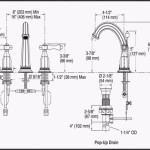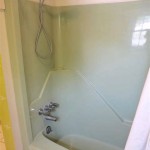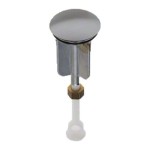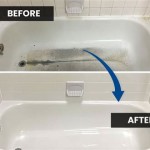Leaking Bathtub Faucet: Replacing a Single Handle Delta Shower Cartridge
A dripping bathtub faucet is more than just an annoyance; it represents wasted water, increased water bills, and potential damage to bathroom fixtures due to persistent moisture. While a plumber can address this issue, replacing a single-handle Delta shower cartridge is often a manageable DIY project for homeowners with basic plumbing skills and tools. This article provides a comprehensive guide to identifying a faulty cartridge, understanding its function, and replacing it to stop the leak.
Delta faucets are widely recognized for their durability and design. However, over time, the internal components, particularly the cartridge, can wear down due to mineral buildup, corrosion, or general wear and tear. The cartridge is essentially the control center of the faucet, regulating the flow and temperature of water. When it malfunctions, it can lead to a constant drip or difficulty in achieving the desired water temperature.
Before embarking on the replacement process, it is crucial to accurately diagnose the source of the leak. While a dripping faucet is a common symptom of a failing cartridge, other issues like worn O-rings or loose connections could be responsible. Observing the faucet closely and noting the specific conditions under which the leak occurs can help pinpoint the problem.
Identifying a Faulty Cartridge
Diagnosing a faulty cartridge requires careful observation and a process of elimination. Several symptoms can indicate a problem with this component:
Persistent Dripping: This is the most common symptom. Even when the faucet is turned off completely, a steady drip persists. The drip may vary in intensity, but it continues regardless of the handle position.
Difficulty Controlling Water Temperature: The handle may become difficult to turn, or it may be challenging to achieve the desired water temperature. Fluctuations in water temperature can occur even when the handle is in a fixed position.
Reduced Water Flow: Even when the handle is fully open, the water flow may be significantly reduced compared to its normal rate. This can be caused by mineral buildup or debris lodged within the cartridge.
Unusual Noises: Strange noises, such as squealing or grinding, may emanate from the faucet when it is turned on or off. These noises often indicate internal damage to the cartridge.
Handle Stiffness: The handle may become excessively stiff or difficult to move. This can be due to mineral deposits or corrosion affecting the cartridge's internal mechanisms.
If any of these symptoms are present, replacing the Delta shower cartridge is a likely solution. However, it is always advisable to rule out other potential causes, such as loose connections or worn O-rings, before proceeding with the replacement.
Preparing for the Replacement
Once a faulty cartridge is suspected, the necessary tools and materials must be gathered. Having everything readily available will streamline the replacement process and minimize disruptions. The following items are typically required:
New Delta Shower Cartridge: It is essential to purchase the correct replacement cartridge for the specific Delta faucet model. The model number is usually located on the faucet body or in the original product documentation. Using the wrong cartridge can lead to compatibility issues and prevent the faucet from functioning correctly.
Screwdriver Set: A set of screwdrivers, including both Phillips head and flathead types, will be needed to remove the handle and any associated screws.
Allen Wrench Set: An Allen wrench set is often required to loosen the set screw that secures the handle to the faucet stem. The appropriate size Allen wrench will vary depending on the faucet model.
Adjustable Wrench: An adjustable wrench is used to grip and turn the cartridge retaining nut or clip. Ensure the wrench is appropriately sized to prevent damage to the nut or clip.
Penetrating Oil: Penetrating oil can be applied to loosen corroded or stuck parts, such as the handle set screw or the cartridge retaining nut. Allow the oil to soak for several minutes before attempting to loosen the parts.
Cartridge Puller (Optional): A cartridge puller is a specialized tool designed to remove stubborn cartridges that are difficult to extract manually. While not always necessary, it can be a valuable asset if the cartridge is tightly lodged within the faucet body.
Clean Cloths or Towels: Clean cloths or towels are essential for wiping up spills and protecting the surrounding surfaces.
Flashlight: A flashlight can be helpful for illuminating the faucet interior and identifying small parts.
Plumber's Grease: Plumber's grease can be applied to the new cartridge's O-rings and seals to ensure a smooth installation and prevent future leaks.
Safety Glasses: Safety glasses protect the eyes from debris and potential splashes of water or cleaning solutions.
Water Shut-Off Key (if necessary): If the individual shut-off valves for the bathtub faucet are inaccessible or malfunctioning, a water shut-off key may be required to turn off the main water supply to the house.
Once all the necessary tools and materials are gathered, the next step is to shut off the water supply to the faucet. Locate the shut-off valves, which are typically located beneath the sink or near the bathtub. Turn the valves clockwise until they are completely closed. If individual shut-off valves are not available, the main water supply to the house must be turned off. After shutting off the water supply, turn on the faucet to relieve any remaining pressure in the pipes.
Replacing the Delta Shower Cartridge: A Step-by-Step Guide
With the tools and materials prepared and the water supply shut off, the actual replacement process can begin. The following steps outline the procedure for replacing a single-handle Delta shower cartridge:
Remove the Handle: Locate the set screw on the faucet handle. This screw is typically concealed beneath a decorative cap or plug. Use an Allen wrench to loosen the set screw and remove the handle. If the handle is stuck, gently rock it back and forth while pulling it away from the faucet body.
Remove the Handle Adapter (if applicable): Some Delta faucets have a handle adapter that connects the handle to the cartridge stem. Remove any screws or retaining clips that secure the adapter to the faucet body. Gently pull the adapter away from the faucet.
Remove the Escutcheon: The escutcheon is the decorative plate that covers the faucet valve. It may be held in place by screws or may simply snap into place. Remove any screws and carefully pry the escutcheon away from the wall. Be careful not to damage the surrounding tile or wall surface.
Remove the Retaining Clip or Nut: Locate the cartridge retaining clip or nut. This component secures the cartridge within the faucet body. The clip is typically a horseshoe-shaped piece of metal that snaps into place. The nut is a threaded ring that screws onto the faucet body. Use an adjustable wrench or pliers to remove the retaining clip or nut.
Remove the Old Cartridge: Once the retaining clip or nut is removed, the old cartridge can be extracted. Grasp the cartridge stem and pull it straight out of the faucet body. If the cartridge is stuck, use a cartridge puller tool to assist in its removal. The cartridge puller typically attaches to the cartridge stem and provides leverage to pull the cartridge out.
Clean the Faucet Body: Use a clean cloth to wipe out the faucet body and remove any debris or mineral buildup. Inspect the faucet body for any signs of damage or corrosion. If necessary, use a mild cleaning solution to remove stubborn deposits.
Install the New Cartridge: Apply a thin layer of plumber's grease to the O-rings and seals of the new cartridge. This will ensure a smooth installation and prevent leaks. Align the cartridge with the faucet body and gently push it into place. Ensure that the cartridge is fully seated and that the stem is properly aligned.
Reinstall the Retaining Clip or Nut: Reinstall the cartridge retaining clip or nut and tighten it securely. Make sure the clip or nut is properly seated and that it is holding the cartridge firmly in place.
Reinstall the Escutcheon: Reinstall the escutcheon and secure it with screws or by snapping it into place. Make sure the escutcheon is properly aligned and that it is flush with the wall surface.
Reinstall the Handle Adapter (if applicable): Reinstall the handle adapter and secure it with screws or retaining clips.
Reinstall the Handle: Reinstall the handle and tighten the set screw. Make sure the handle is properly aligned and that it is securely attached to the faucet stem.
Turn on the Water Supply: Slowly turn on the water supply to the faucet. Check for leaks around the handle, escutcheon, and spout. If any leaks are present, tighten the appropriate connections or replace any worn O-rings or seals.
Test the Faucet: Turn the faucet on and off several times to ensure that it is functioning properly. Check the water temperature and flow rate. If the faucet is still dripping or if the water temperature is not correct, the cartridge may not be properly installed or there may be another issue with the faucet.
By following these steps carefully, homeowners can successfully replace a single-handle Delta shower cartridge and eliminate a leaking bathtub faucet. If any difficulties are encountered or if the faucet continues to leak after the replacement, it is advisable to consult a qualified plumber.

How To Repair A Delta Tub Shower Valve

How To Replace A Delta Cartridge And Fix Leaky Bathtub Faucet It Tutorials

Fix A Leaky Delta Single Handle Shower Faucet For Under 2

Delta Shower And Tub Cartridge Replacement What You Need To Know

How To Fix A Leaky Shower Faucet Delta Cartridge Replacement

How To Replace A Dripping Leaking Delta Tub Shower Cartridge

My 1300 1400 Series Monitor Is Leaking From The Shower Head Or Spout When Handle Off What Do I Need

How To Fix A Leaky Bathtub Faucet Delta Shower Cartridge L Replace

I Fixed A Leak In The Delta Tub Shower Single Handle Faucet

Shower Faucet Repair Advocate Master Plumbing
Related Posts








